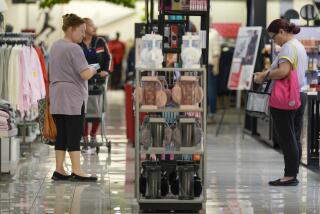Cautious shoppers turn to discounters
- Share via
Consumers pummeled by high gasoline and food prices flocked to the nation’s discount stores for the back-to-school season, leaving department stores and other sectors struggling throughout August.
Demand for necessities helped chains such as retail giant Wal-Mart Stores Inc. perform above expectations, while discounts and promotions at several apparel and teen businesses coaxed some discretionary spending out of shoppers, the stores reported Thursday.
Still, analysts said consumers might continue to buckle down and save straight through winter, intensifying their bargain hunting during holiday and post-Christmas shopping.
“We’re looking at a muted holiday season, where shoppers are procrastinating until things go on sale,” said Betty Chen, an analyst with Wedbush Morgan Securities. “And with five fewer days between Thanksgiving and Christmas, it’ll be critical for retailers to drive as much sales as possible before then.”
Overall, same-store sales numbers for August that were released Thursday showed that retailers saw sales swell 1.7%. But the average stalled at the August 2007 level when Wal-Mart’s data is excluded, according to the International Council of Shopping Centers’ tally of 36 stores.
Several chains, such as City of Industry-based Hot Topic Inc., performed better than expected, but only because expectations were low to begin with, analysts said. J.C. Penney beat estimates by 1.4%, but still saw sales droop 4.9%. The 8% fall at Gap Inc. was slightly less steep than the forecasted 9.7%.
The rocky summer encouraged pessimism, several analysts said, with the unemployment rate at a 12-year high, July’s inflation surging to a 17-year peak and the Federal Reserve painting a dour portrait of a “soft” and “subdued” economy in a report Wednesday.
The Dow Jones industrial average plummeted nearly 350 points Thursday after the release of the retail numbers and a Labor Department announcement that last week’s new applications for unemployment insurance rose 15,000 from the week before.
Margaret Rodriguez, 65, a retired office manager from Alhambra, stopped by a Mervyns department store Thursday because she thought the store was having a buy one, get one free sale.
Nowadays, Rodriguez says, she only ventures into upscale retailer Nordstrom to look at merchandise, never to buy. She’s downsized to discount chains, where she scours 80%-off racks for deals and pairs all her purchases with coupons.
She needs new curtains and a bedspread, but plans to hold off until J.C. Penney’s sale in February.
“My shopping has diminished completely,” Rodriguez said. “There’s too many essential things I need to get, but it kills me to even put $60 of gas in my small little car.”
The forecast for September looks ominous, said Britt Beemer, chairman of consumer behavior firm America’s Research Group.
Foot traffic was strong during the Labor Day weekend, which often makes up 20% of September sales, he said. But other analysts suggested that with some classes starting later in the month, extended back-to-school sales could buffer revenue. The shopping centers council is predicting a 2% increase overall.
But even with a boost from the Labor Day weekend, most of which fell in August this year, and a strong fourth week because of slipping gasoline prices, August numbers were still dismal, Beemer said.
It’s not that shoppers were staying in, analysts said. But discounters wrested away business from other sectors by offering one-stop shopping and cheaper essentials.
“The biggest issue is that gasoline and higher grocery prices sucked out $400 to $500 more a month out of families’ budgets, so now they have to look at everything as an expense and maximize everything they buy,” Beemer said.
Wal-Mart was a standout in August, with a 3% gain that surpassed the anticipated 1.6%, because of healthy sales of its grocery, health and wellness and technology products, according to a company statement Thursday.
Costco Wholesale Corp. reported that sales grew 9%, but missed analysts’ estimate for a 9.9% increase. Sales at BJ’s Wholesale Club Inc. climbed 15.4%.
Department and apparel stores fared less well, stumbling 6.3% and 3.4% respectively, according to Thomson Reuters’ compilation of 36 chains. Many stores were saddled with expensive brand names that few consumers could afford, Chen said.
“When times get tough, things like apparel all get put on the back shelf,” Beemer said. “Now you only buy those items that you have to have.”
Chico’s FAS Inc. plunged 10%, Nordstrom Inc. dropped 7.9% and Limited Brands Inc. fell 7%. Sales at Los Angeles-based American Apparel Inc., however, soared 31%.
Some retailers, especially in the teen market, topped expectations by slashing prices, Chen said. Although the segment as a whole dropped 2.6%, Aeropostale Inc.’s numbers boomed 13% and Buckle Inc. shot up 22.4%.
But the luxury market fared worse than expected as stores lost their aspirational shoppers and revenue.
“Even if people have money,” Beemer said, “they don’t feel wealthy nowadays.”
--
--
(BEGIN TEXT OF INFOBOX)
Mixed bag
August was another rough month for retailers, who reported disappointing back-to-school shopping. Consumers continued to trim discretionary spending.
Year-over-year percentage change in August sales at stores open at least a year
Company: Change
Costco: +9.0%
Ross: +3.0%
Wal-Mart: +3.0%
Neiman Marcus: -0.5%
Target: -2.1%
Hot Topic: -2.7%
J.C. Penney: -4.9%
Saks: -5.9%
Pacific Sunwear: -6.0%
Limited Brands: -7.0%
Nordstrom: -7.9%
Gap: -8.0%
Wet Seal: -8.7%
--
Sources: Thomson Reuters, Retail Metrics, Times research
--
Los Angeles Times
More to Read
Inside the business of entertainment
The Wide Shot brings you news, analysis and insights on everything from streaming wars to production — and what it all means for the future.
You may occasionally receive promotional content from the Los Angeles Times.











